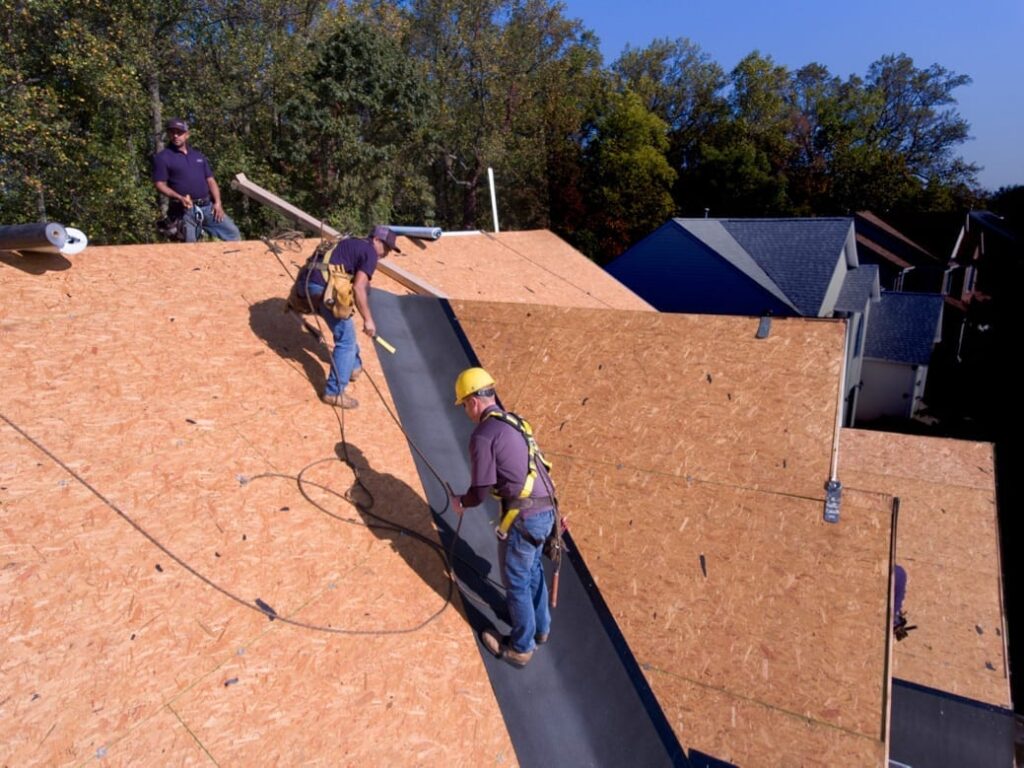Roofers face a tough job, especially during hot months. They need to finish tasks efficiently while dealing with intense heat, which can harm their health and safety. Knowing when it’s too hot to work on a roof is crucial to prevent heat-related illnesses and ensure their well-being. This guide will help you understand the signs and guidelines for safe roofing under the sun.

Understanding Heat-Related Risks in Roofing
Roofing materials, especially metal and black asphalt, absorb and radiate heat, significantly elevating temperatures on the roof surface. This can make the working environment hazardous during hot weather. The risks associated with working on a hot roof include:
- Heat Exhaustion and Heat Stroke: These are the most severe health concerns, as they can be life-threatening if not promptly treated. Symptoms include dizziness, confusion, excessive sweating, and fainting.
- Dehydration: Constant exposure to high temperatures increases the risk of dehydration, which can impair a roofer’s ability to function and concentrate, increasing the likelihood of accidents.
- Burns: Roofing materials and tools heated by the sun can cause burns upon contact, requiring workers to wear protective clothing that unfortunately also contributes to heat stress.
- Decreased Efficiency and Increased Mistakes: Heat stress affects cognitive and physical performance, potentially leading to errors that could jeopardize the quality of the roofing work and safety.
When Is It Too Hot to Work on a Roof?
Determining when it is too hot to work on a roof involves several factors, including the temperature, humidity, and the heat index. Here’s how to make that determination:
- Check Local Weather Guidelines and OSHA Standards: The Occupational Safety and Health Administration (OSHA) does not set specific temperature limits, but it recommends precautionary measures when the heat index rises above 91°F (33°C). Many professionals consider temperatures above 90°F with direct exposure to sunlight as too hot for roofing work without extra safety precautions.
- Monitor the Heat Index: The heat index is a more accurate measure than air temperature alone because it considers humidity, which can affect the body’s ability to cool itself through sweating. Roofers should use weather apps or websites to monitor the heat index and plan their work schedule accordingly.
- Use a Wet-Bulb Globe Temperature (WBGT) Meter: This device measures heat stress in direct sunlight, accounting for temperature, humidity, wind speed, sun angle, and cloud cover. A WBGT reading that is above 89.6°F (32°C) is considered unsafe for intense physical activities like roofing.
Precautions and Recommendations for Hot Weather Roofing
Even on days when it is technically safe to work on a roof, taking the proper precautions is vital for safety. Here are some recommended strategies:
- Start Early or Work Late: Schedule work during the cooler parts of the day, such as early morning or late afternoon. Avoid midday when the sun is most intense.
- Stay Hydrated: Drink plenty of water throughout the day. Avoid caffeine and sugary drinks, as they can lead to dehydration.
- Take Regular Breaks: Use shaded or air-conditioned areas for breaks to allow the body to cool down.
- Wear Appropriate Clothing: Light-colored, loose-fitting, and breathable clothing helps keep body temperatures down. Hats and UV-protective eyewear are also essential.
- Use Sunscreen: Apply sunscreen with an SPF of at least 30 to all exposed skin, reapplying every two hours.
- Adapt Work Practices: Modify work schedules to be shorter and include more frequent breaks as the heat index rises. Monitor workers for signs of heat-related illness.

Legal and Safety Responsibilities
Employers are legally obligated to provide a safe working environment, which includes protecting workers from extreme heat. Implementing a heat illness prevention plan is essential. This plan should include training for workers on recognizing the signs of heat-related illnesses and the immediate steps to take if they or a coworker are affected.
Conclusion
Knowing when it is too hot to work on a roof and taking the necessary precautions are critical components of roofing safety. The intense heat not only poses severe health risks but also affects the overall quality of the work. By adhering to safety guidelines, monitoring weather conditions, and employing protective measures, roofers can safeguard their health and deliver quality workmanship, no matter the temperature. Remember, the goal is to ensure that everyone goes home safe and healthy at the end of the workday. Prioritizing safety over productivity not only protects workers but also upholds the integrity and reputation of the roofing industry.
